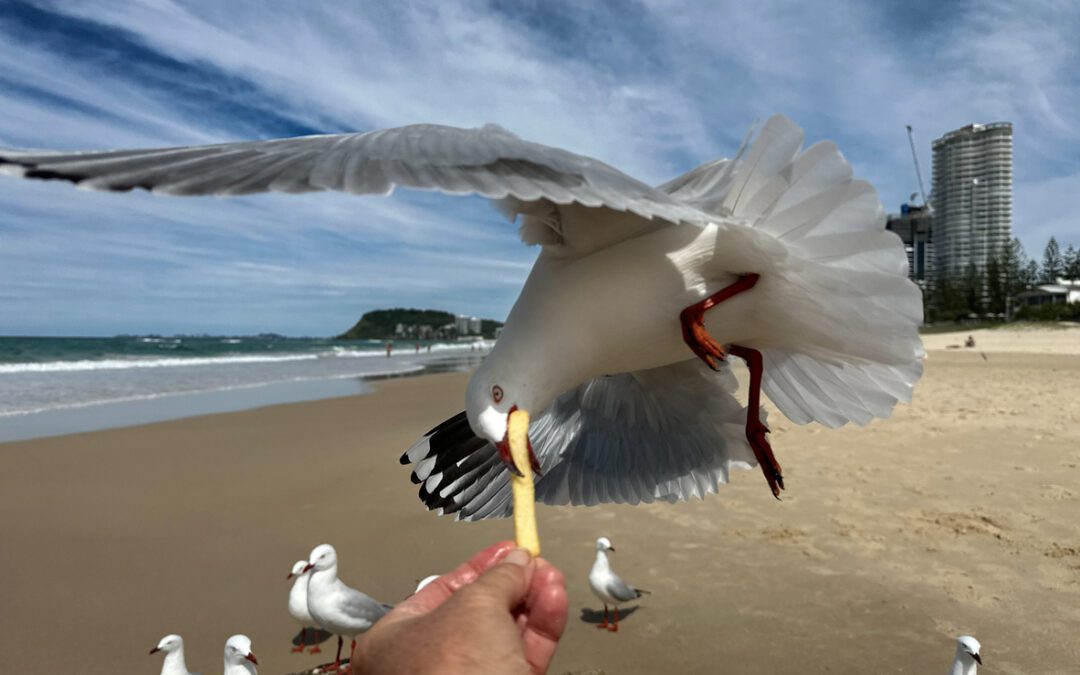
by Pigeon Patrol | Sep 19, 2024 | Pigeons, Pigeons in the News, Raccoons
The New York Pigeon is a photography book that reveals the unexpected beauty of the omnipresent pigeon as if Vogue magazine devoted its pages to birds, rather than fashion models. In spite of pigeons’ ubiquity in New York and other cities, we never really see them closely and know very little about their function in the urban ecosystem. This book brings to light the intriguing history, behavior and splendor of a bird that we frequently overlook.
The result of eight years of passionate inquiry is a photographic study of the birds’ power and allure (as seen on the cover of New York magazine and the New York Times). The dramatic, hyper-real individual studio portraits capture the personalities, expressiveness, glorious feather iridescence and deeply hued eyes. High-speed strobe photography illustrates pigeons’ graceful flight and dramatic wing movements (as featured in Audubon magazine).
While The New York Pigeon is primarily a photography book, it also tells the five-thousand-year story of the feral pigeon. Why are pigeons so successful in cities and not in the countryside? Why do they have such diverse plumage? How have pigeons adapted to survive on almost any food? Why are pigeons able to fly up to 500 miles per day but rarely do?
How did Harvard psychologist B.F. Skinner teach pigeons to do complicated tasks, from tracking missile targets to recognizing individual human faces? Why can pigeons see in the ultraviolet light spectrum and half of their brain is used for visual perception?
The New York Pigeon lovingly describes and illuminates the beauty of nature that is alive in our midst. With this book, the beautiful, savvy, graceful, kind pigeon will be invisible no more.
Andrew Garn is a native New Yorker who grew up surrounded by pigeons, he has been photographing, rehabilitating and observing Columba Livia for eight years. Since 2008, when he exhibited photographs, video installations and sculptures of pigeons at A.M. Richard Fine Art in Brooklyn, NY, he has continued to photograph them. Documenting the entire spectrum of development, including full-grown pigeons, newborns, babies and “squeakers”, he has grown to love these birds.
Mr. Garn is a fine art and editorial photographer whose work has been widely exhibited and appeared in the pages of numerous magazines including the New York Times Magazine, Fortune, Forbes, Interview, Vogue, Vibe, Time, Newsweek, Der Spiegel, French Photo, Elle Décor, New York and Bloomberg LP. He is also the recipient of grants from the New York State Council on the Arts, the Graham Foundation, the National Endowment for the Arts, and the J.M. Kaplan Fund, among others.
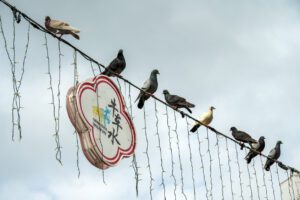
Singapore, Singapore – April 2, 2024. Pigeons standing on wire in Chinatown, Singapore
His previous books include Exit to Tomorrow: The History of the Future (Rizzoli, 2007), Subway Style: Architecture and Design of the NYC Subway (Stewart, Tabori & Chang, and the MTA 2005), winner of New York Society Book Award, The Houseboat Book (Rizzoli/Universe 2003), and Bethlehem Steel (Princeton Architectural Press 2000).
Emily S. Rueb is an editor for the New York Times metropolitan section. She writes regularly on avian subjects and was the creator of Bird Week and the “Hawk Cam” which chronicled the lives of a red-tailed hawk family in Washington Square Park.
Rita McMahon is the founding director of New York City’s only wildlife rehabilitation facility the Wild Bird Fund. The non- profit facility, operated by
volunteers and vet science trainees helps over 4,500 injured birds per year.
Pigeon Patrol
Pigeon Patrol Products & Services is the leading manufacturer and distributor of bird deterrent (control) products in Canada. Pigeon Patrol products have solved pest bird problems in industrial, commercial, and residential settings since 2000, by using safe and humane bird deterrents with only bird and animal -friendly solutions. At Pigeon Patrol, we manufacture and offer a variety of bird deterrents, ranging from Ultra-flex Bird Spikes with UV protection, Bird Netting, 4-S Bird Gel and the best Ultrasonic and audible sound devices on the market today.
Canada’s top wholesaler for bird deterrent products for twelve consecutive years.
Contact us at 1- 877– 4– NO-BIRD, (604) 585-9279 or visit our website at https://www.pigeonpatrol.ca/
Bird Gone, Pigeon Gone, Pigeon problems, pigeon spikes, 1-877-4NO-BIRD, 4-S Gel, Bird Control, Pigeon Control, bird repellent, Bird Spikes, sonic bird repellent, stainless steel bird spikes, bird spikes Vancouver, Ultra Sonic Bird Control, Bird Netting, Plastic Bird Spikes, Canada bird spike deterrents, Pigeon Pests, B Gone Pigeon, Pigeon Patrol, pest controller, pest control operator, pest control technician, Pigeon Control Products, humane pigeon spikes, pigeon deterrents, pigeon traps, Pigeon repellents, Sound & Laser Deterrents, wildlife control, raccoon, skunk, squirrel deterrent, De-Fence Spikes, Dragons Den, Pigeon, Pigeon Patrol, Pigeons Roosting, Vancouver Pigeon Control, Bird Spikes, Bird Control, Bird Deterrent, Pigeon Deterrent, Surrey Pigeon Control, Pest, Seagull deterrent Vancouver Pigeon Blog, Birds Inside Home De-fence, Pigeon Nesting, Bird Droppings, Pigeon Dropping, woodpecker control, Keep The Birds Away, Birds/rats, seagull, pigeon, woodpecker, dove, sparrow, pidgeon control, pidgeon problem, pidgeon control, flying rats, pigeon Problems, bird netting, bird gel, bird spray, bird nails, bird guard, Pigeon control, Bird deterrents, Pigeon deterrents, Bird control, solutions, Pigeon prevention, Pigeon repellent, Bird proofing, Pest bird management, Pigeon spikes, Bird netting, Humane bird control, Bird exclusion, Urban bird control, Anti-roosting devices, Pigeon removal, Bird barriers
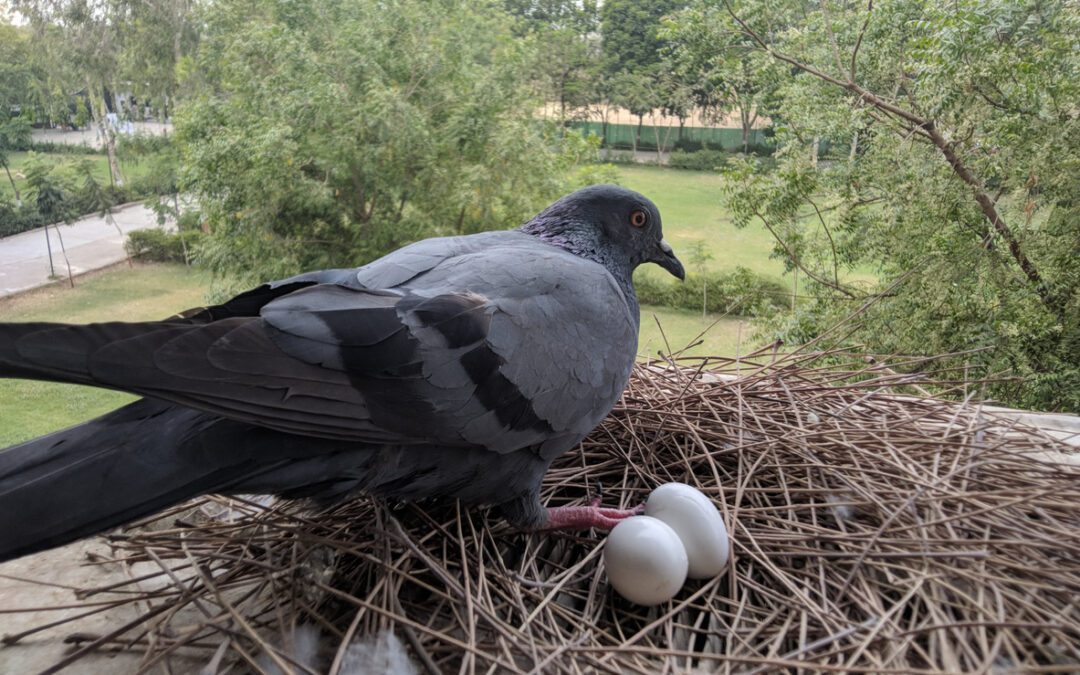
by Pigeon Patrol | Sep 19, 2024 | Bird Spike, Pigeons, Sparrows
Homing pigeons with their cryptic inborn GPS systems have been reliably delivering messages for at least three millennia. Pigeons announced the winners of ancient Olympiads. They delivered military messages for Genghis Khan and were the first to reach England with the outcome of the Battle of Waterloo. They’ve brought home the mail in war and peace. Many were awarded medals for distinguished service in World Wars One and Two.2 (No less amazing, of course, are the enormous migratory feats of other birds, but homing pigeons are easier to study because they travel on cue and not in response to the seasons.)
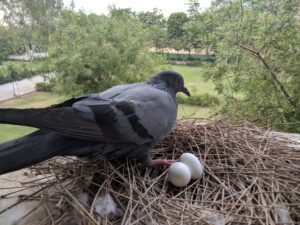
Pigeon With Egg in the nest photography. Birds Photography. Pigeon Hatching Eggs
And while “the magnetic sense of pigeons provides an excellent compass for orientation,” writes Hagstrum, “the geomagnetic field makes a poor map.”
Homing pigeons likely rely on a number of sensory cues to find their way home. While vision may be valuable locally, birds with frosted contact lenses manage to arrive after long trips to within 500 meters of their destination, so sight doesn’t seem to be the key.3 And while “the magnetic sense of pigeons provides an excellent compass for orientation,” writes Hagstrum, “the geomagnetic field makes a poor map.”4
The June 1997 pigeon disaster was one of four pigeon races disrupted in 1997 and 1998 in Europe and the northeastern United States. The only common element, as Hagstrum reported back in the year 2000, was the intersection of the racecourses with the path of an accelerating Concorde supersonic transport.5 This finding supported the idea that pigeons don’t achieve their precision long-distance navigation through reliance on vision or the earth’s magnetic field, since sonic booms disrupt neither. Yet the question remained: how do sonic booms disturb the birds’ natural abilities?
Hagstrum said, “When I realized the birds in that race were on the same flight path as the Concorde, I knew it had to be infrasound.” Infrasound is extremely low frequency sound generated by deep ocean waves. These waves cause tiny vibrations of planetary surfaces and atmosphere, called microseisms and microbaroms, respectively. Because of variations in terrain, infrasonic characteristics can form a map of the landscape.
Hagstrum’s latest study, published 15 February 2013 in the Journal of Experimental Biology, sorted through data on pigeon flights in upstate New York between 1968 and 1987 and confirmed that sonic boom disruption of the “sounds of silence” was likely responsible for the 1997 loss of over 60,000 trained birds. Moreover, his study represents a major piece for the how-birds-navigate puzzle.
The New York birds were part of a Cornell University experimental program. For nearly two decades researchers recorded that birds released from one of three standard sites—Jersey Hill—generally failed to make it home. Those from the other sites could find their way. Only once in those two decades did the Jersey Hill birds make it home to Cornell: on August 13, 1969. Meteorological records demonstrated that the area on that day experienced a temperature inversion. Hagstrum believes, based on acoustic modeling, that the terrain of the path between Jersey Hill and Cornell normally creates a “sound shadow,” obscuring the home loft by directing the infrasonic signals associated with it high into the atmosphere. On the one good day, differing atmospheric conditions would have made the infrasonic signals detectable to birds from Jersey Hill.6
Hagstrum believes that infrasonic signals from a home loft normally act like a homing beacon for birds to get their bearings as they orient using other signals such as the sun or stars, the earth’s magnetic field, and visual or olfactory clues.7 Ill-timed sonic booms, earthquakes, and terrain that coincidentally misdirects the sound waves as they propagate through the air all have the potential to disrupt infrasonic signals that normally bring these birds home.
You may listen to these subtle sounds yourself in amplified recordings from the University of Hawaii Infrasound Laboratory.8 As you listen, marvel at the ways God designed for birds to find their way using an earthward-directed GPS-like system for more than 6,000 years since creation.
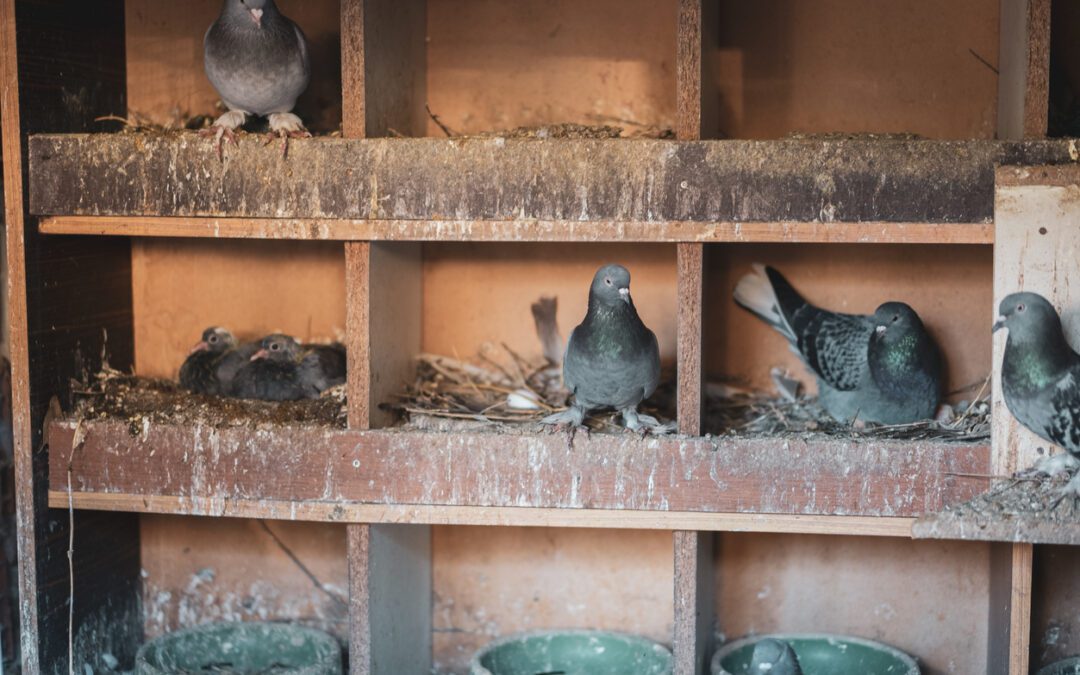
by Pigeon Patrol | Jul 9, 2024 | Animal Deterrent Products, Bird Netting, Bird Spike, Columbidae, Pigeon Spikes, Pigeons, Sparrows
Eagles and falcons deployed to scare away pigeons in Barcelona
This article is more than 3 months old Trial project aims to drive colonies causing a nuisance at Camp Nou football stadium to nearby parks
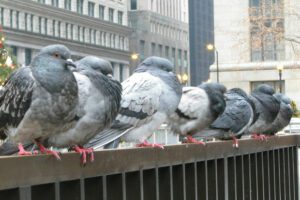
Barcelona has recruited a new weapon in its fight to keep the urban pigeon population under control: eagles and falcons.
As part of a trial, teams of three or four birds of prey have started patrolling an area around Camp Nou, FC Barcelona’s football ground, between 8am and 4pm. Pigeons nesting in the ground have been driven out by building works and have relocated to nearby blocks of flats whose residents have demanded action.
The idea is to drive the pigeons into nearby parks where they will be less of a nuisance.
“The birds can eat a few pigeons but that’s not the idea,” said Albert Tomás, a spokesperson for the company contracted to carry out the work. “Besides, a dead pigeon doesn’t learn.”
The mere sight of low-flying birds of prey was enough to unsettle the pigeons, which soon get the message that it was time to move on, said Tomás.
The pilot scheme follows the city’s failed effort to control the population of the estimated 85,000 pigeons through spiking their food with a contraceptive.
In some areas, such as the Plaça de Catalunya in the city centre, the concentration of birds is twice the recommended number.
In 2017 the city successfully used birds of prey to disperse flocks of pigeons that were damaging the roof of the Palau Sant Jordi concert hall.
Carmen Maté, responsible for animal welfare in the city, said that if the Camp Nou pilot proved successful it would be extended to other parts of Barcelona. The city is also campaigning to stop people discarding food in the street, which encourages the growth of the pigeon population.
Most Spanish airports use teams of falcons to deter bird strikes which are estimated to cost the global airline industry $1.2bn (£950,000) a year.
Barcelona airport has a team of 80 falcons, while about 70 peregrine falcons patrol Barajas airport in Madrid.
This is what we’re up against
Teams of lawyers from the rich and powerful trying to stop us publishing stories they don’t want you to see.
Lobby groups with opaque funding who are determined to undermine facts about the climate emergency and other established science.
Pigeon Patrol
Pigeon Patrol Products & Services is the leading manufacturer and distributor of bird deterrent (control) products in Canada. Pigeon Patrol products have solved pest bird problems in industrial, commercial, and residential settings since 2000, by using safe and humane bird deterrents with only bird and animal friendly solutions. At Pigeon Patrol, we manufacture and offer a variety of bird deterrents, ranging from Ultra-flex Bird Spikes with UV protection, Bird Netting, 4-S Bird Gel and the best Ultrasonic and audible sound devices on the market today.
Canada’s top wholesaler for bird deterrent products for twelve consecutive years.
Contact us at 1- 877– 4– NO-BIRD, (604) 585-9279 or visit our website at https://www.pigeonpatrol.ca/
Bird Gone, Pigeon Gone, Pigeon problems, pigeon spikes, 1-877-4NO-BIRD, 4-S Gel, Bird Control, Pigeon Control, bird repellent, Bird Spikes, sonic bird repellent, stainless steel bird spikes, bird spikes Vancouver, Ultra Sonic Bird Control, Bird Netting, Plastic Bird Spikes, Canada bird spike deterrents, Pigeon Pests, B Gone Pigeon, Pigeon Patrol, pest controller, pest control operator, pest control technician, Pigeon Control Products, humane pigeon spikes, pigeon deterrents, pigeon traps, Pigeon repellents, Sound & Laser Deterrents, wildlife control, raccoon, skunk, squirrel deterrent, De-Fence Spikes, Dragons Den, Pigeon, Pigeon Patrol, Pigeons Roosting, Vancouver Pigeon Control, Bird Spikes, Bird Control, Bird Deterrent, Pigeon Deterrent, Surrey Pigeon Control, Pest, Seagull deterrent Vancouver Pigeon Blog, Birds Inside Home De-fence, Pigeon Nesting, Bird Droppings, Pigeon Dropping, woodpecker control, Keep The Birds Away, Birds/rats, seagull, pigeon, woodpecker, dove, sparrow, pidgeon control, pidgeon problem, pidgeon control, flying rats, pigeon Problems, bird netting, bird gel, bird spray, bird nails, bird guard, Pigeon control, Bird deterrents, Pigeon deterrents, Bird control, solutions, Pigeon prevention, Pigeon repellent, Bird proofing, Pest bird management, Pigeon spikes, Bird netting, Humane bird control, Bird exclusion, Urban bird control, Anti-roosting devices, Pigeon removal, Bird barriers

by Pigeon Patrol | Mar 11, 2024 | Bird Spike, Pigeon Droppings, Pigeon Predators, Pigeons, Pigeons in the News, Raccoons
Wildlife rehabilitation calls for city to ban toxins that poison Saskatoon pigeons “Basically if you can imagine a bird having seizures,” said Jan Shadick, Living Sky Wildlife Rehabilitation executive director, describing a pigeon’s painful death after eating poisoned corn. “It’s an unfortunate way to die and it’s an unfortunate use of pigeon control methods within the city.”
The most common poison used is Avitrol. Shadick said she wants to see the city ban its use, or at least require the area it’s scattered around to be labelled, like when spraying pesticides. She said her wildlife rehabilitation sees hundreds of poisoned pigeons — and some other birds — a year, but they’re also seeing it punch up the food chain. “Dogs and cats have been demonstrated to have eaten these poison pigeons and died from it,” she said. “A crow would eat it, a raven would eat it, numerous birds would eat it and it was open to anybody who wanted a free lunch. A squirrel could get a hold of it,” explained owner Jason Hiltz. Instead, he said the company uses deterrents like nets and pigeon spikes.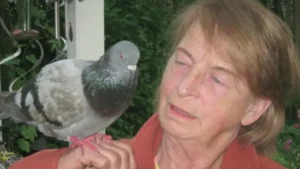
Two years ago, the City of Saskatoon banned the use of poisoned corn according to Shadick, but only on city property. Shadick said it hasn’t made a difference. She said while most poisons to kill birds can only be bought by licensed professionals, some companies sell almost identical products to anyone online. “The money that people are currently spending on putting out poisoned corn could be spent putting out birth control corn,” she said, explaining using birth control is a more humane version of pigeon population control.
Pigeon Patrol
Pigeon Patrol Products & Services is the leading manufacturer and distributor of bird deterrent (control) products in Canada. Pigeon Patrol products have solved pest bird problems in industrial, commercial, and residential settings since 2000, by using safe and humane bird deterrents with only bird and animal friendly solutions. At Pigeon Patrol, we manufacture and offer a variety of bird deterrents, ranging from Ultra-flex Bird Spikes with UV protection, Bird Netting, 4-S Bird Gel and the best Ultrasonic and audible sound devices on the market today.
Canada’s top wholesaler for bird deterrent products for twelve consecutive years.
Contact us at 1- 877– 4– NO-BIRD, (604) 585-9279 or visit our website at https://www.pigeonpatrol.ca/
Bird Gone, Pigeon Gone, Pigeon problems, pigeon spikes, 1-877-4NO-BIRD, 4-S Gel, Bird Control, Pigeon Control, bird repellent, Bird Spikes, sonic bird repellent, stainless steel bird spikes, bird spikes Vancouver, Ultra Sonic Bird Control, Bird Netting, Plastic Bird Spikes, Canada bird spike deterrents, Pigeon Pests, B Gone Pigeon, Pigeon Patrol, pest controller, pest control operator, pest control technician, Pigeon Control Products, humane pigeon spikes, pigeon deterrents, pigeon traps, Pigeon repellents, Sound & Laser Deterrents, wildlife control, raccoon, skunk, squirrel deterrent, De-Fence Spikes, Dragons Den, Pigeon, Pigeon Patrol, Pigeons Roosting, Vancouver Pigeon Control, Bird Spikes, Bird Control, Bird Deterrent, Pigeon Deterrent, Surrey Pigeon Control, Pest, Seagull deterrent Vancouver Pigeon Blog, Birds Inside Home De-fence, Pigeon Nesting, Bird Droppings, Pigeon Dropping, woodpecker control, Keep The Birds Away, Birds/rats, seagull, pigeon, woodpecker, dove, sparrow, pidgeon control, pidgeon problem, pidgeon control, flying rats, pigeon Problems, bird netting, bird gel, bird spray, bird nails, bird guard, Pigeon control, Bird deterrents, Pigeon deterrents, Bird control, solutions, Pigeon prevention, Pigeon repellent, Bird proofing, Pest bird management, Pigeon spikes, Bird netting, Humane bird control, Bird exclusion, Urban bird control, Anti-roosting devices, Pigeon removal, Bird barriers
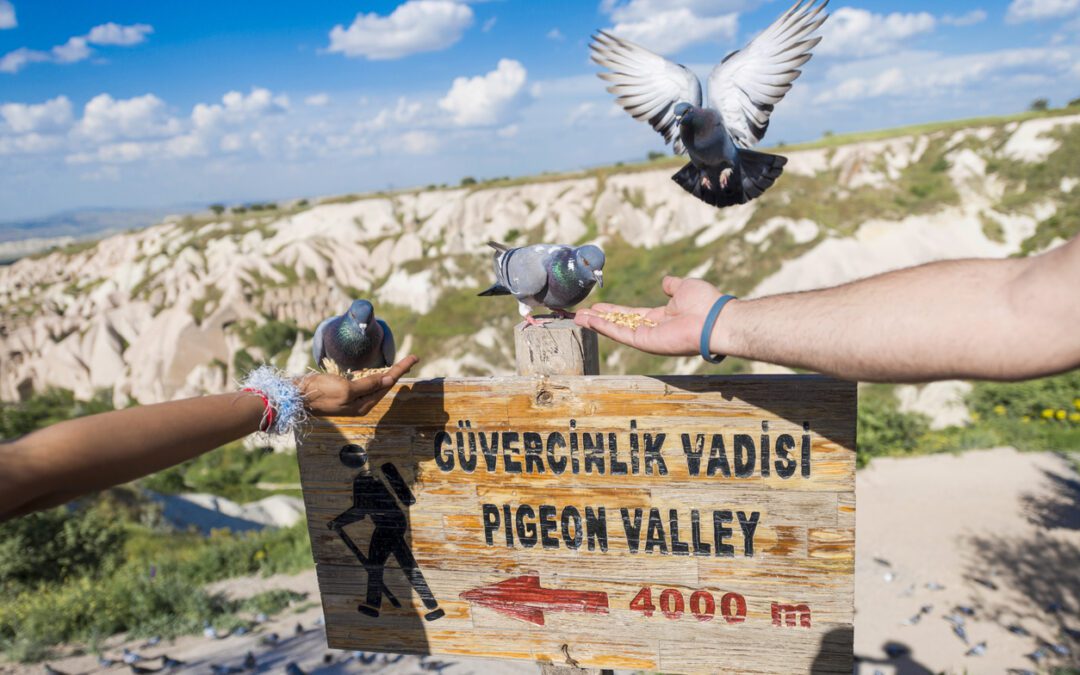
by Pigeon Patrol | Mar 11, 2024 | Bird Netting, Bird Spikes, Columbidae, Pigeons, Pigeons in the News, Sparrows
Prison guards at the Pacific Institution in Abbotsford intercepted a pigeon with a small backpack containing crystal meth Prison guards in B.C.’s Fraser Valley have to be vigilant against drones trying to drop contraband to waiting inmates or someone trying to throw drugs over the walls, but a recent discovery has also caused some concern.
“A pigeon was located at Pacific Institution, inside the walls, and it appeared to have a small package, sort of like a backpack attached to it,” John Randle, president of the Pacific Region for Union of Canadian Correctional Officers told Global News. He said the package contained crystal meth. The incident reportedly happened on Dec. 29 at the maximum, medium and minimum federal penitentiary located in Abbotsford. Randle said the pigeon was found near one of the recreation yards at the institution.
“It was spotted by correctional officers, I believe, and security intelligence officers when the officers were doing their standard patrols around and throughout the unit and institution, that’s when they initially spotted the bird with the package on it,” he said. “And then, of course, I believe there was some creative work – because the bird moved around quite a bit – in order to track it and capture it. But it was just outside one of the unit yards when it was first spotted.” Peruvian police catch “narco pigeon” trying to smuggle marijuana into prison
Randle said they have had issues with contraband in the past, with drones or something being thrown over the wall, but in his 13-year career, he has never heard of birds being used to smuggle something into a prison. “It’s almost like the inmates and the criminals are going back in time and using older technology,” he said.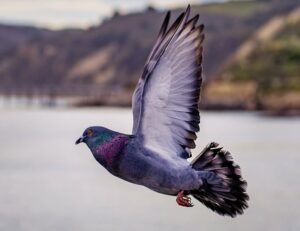
In November, Mission Institution was locked down for days due to a belief that a drone may have dropped a firearm onto the prison grounds. The lockdown was lifted when no gun was found but officers did locate a drone. Lost pigeon flew the coop, finding her way from France to Calgary Randle said keeping drugs out of the prisons has become a huge part of correctional officers’ jobs every day, not just in B.C. but across Canada. “Especially with drones and throw-overs, the drug problem is growing on a daily basis,” he said. “This pigeon thing adds a new element to that for sure and we’ll be on the lookout for it but definitely drones have been the big thing for us.” He added that right now it is unclear to investigators if someone inside the prison was training the bird or if it was someone outside the institution. Randle said they have increased staff and patrols in order to watch for any potential drops. He said they also have anti-drone technology that works like a radar.
The Correctional Service of Canada and the RCMP have launched a joint investigation into what happened.
Pigeon Patrol
Pigeon Patrol Products & Services is the leading manufacturer and distributor of bird deterrent (control) products in Canada. Pigeon Patrol products have solved pest bird problems in industrial, commercial, and residential settings since 2000, by using safe and humane bird deterrents with only bird and animal friendly solutions. At Pigeon Patrol, we manufacture and offer a variety of bird deterrents, ranging from Ultra-flex Bird Spikes with UV protection, Bird Netting, 4-S Bird Gel and the best Ultrasonic and audible sound devices on the market today.
Canada’s top wholesaler for bird deterrent products for twelve consecutive years.
Contact us at 1- 877– 4– NO-BIRD, (604) 585-9279 or visit our website at https://www.pigeonpatrol.ca/
Bird Gone, Pigeon Gone, Pigeon problems, pigeon spikes, 1-877-4NO-BIRD, 4-S Gel, Bird Control, Pigeon Control, bird repellent, Bird Spikes, sonic bird repellent, stainless steel bird spikes, bird spikes Vancouver, Ultra Sonic Bird Control, Bird Netting, Plastic Bird Spikes, Canada bird spike deterrents, Pigeon Pests, B Gone Pigeon, Pigeon Patrol, pest controller, pest control operator, pest control technician, Pigeon Control Products, humane pigeon spikes, pigeon deterrents, pigeon traps, Pigeon repellents, Sound & Laser Deterrents, wildlife control, raccoon, skunk, squirrel deterrent, De-Fence Spikes, Dragons Den, Pigeon, Pigeon Patrol, Pigeons Roosting, Vancouver Pigeon Control, Bird Spikes, Bird Control, Bird Deterrent, Pigeon Deterrent, Surrey Pigeon Control, Pest, Seagull deterrent Vancouver Pigeon Blog, Birds Inside Home De-fence, Pigeon Nesting, Bird Droppings, Pigeon Dropping, woodpecker control, Keep The Birds Away, Birds/rats, seagull, pigeon, woodpecker, dove, sparrow, pidgeon control, pidgeon problem, pidgeon control, flying rats, pigeon Problems, bird netting, bird gel, bird spray, bird nails, bird guard, Pigeon control, Bird deterrents, Pigeon deterrents, Bird control, solutions, Pigeon prevention, Pigeon repellent, Bird proofing, Pest bird management, Pigeon spikes, Bird netting, Humane bird control, Bird exclusion, Urban bird control, Anti-roosting devices, Pigeon removal, Bird barriers
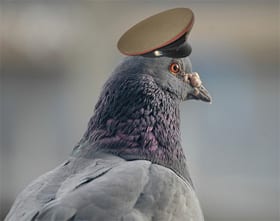
by Pigeon Patrol | Nov 7, 2023 | Bird Spike, Pigeon Spikes, Pigeons, Pigeons in the News, Raccoons, Sparrows, UltraSonic Bird Control
TORONTO – A pigeon has been stealing poppies from the Tomb of the Unknown Australian Soldier at the Australian War Memorial in Canberra and making a nest out of the flowers in the alcove of a stained glass window.
“Each day the pigeon has been flying down… to steal poppies, carefully crafting a nest in the lead-up to Remembrance Day in an alcove above the stained-glass window of a wounded Australian soldier,” the website for the Australian War Memorial reads.
The poignancy of the bird using the unusual nest materials is not lost on the Memorial’s staff, as the website explores the history of soldiers using pigeons during wartime.

“Between 1942 and 1943, pigeon fanciers across the country gave some 13,500 trained pigeons to the army for signals use purposes,” the website says. “There are lots of stories of pigeons valiantly going forward and saving people’s lives.”
Source
Pigeon Patrol Products & Services is the leading manufacturer and distributor or bird deterrent (control) products in Canada. Pigeon Patrol products have solved pest bird problems in industrial, commercial, and residential settings since 2000, by using safe and humane bird
deterrents with only bird and animal friendly solutions. At Pigeon Patrol, we manufacture and offer a variety of bird deterrents, ranging from Ultra-flex Bird Spikes with UV protection, Bird Netting, 4-S Bird Gel and the best Ultrasonic and audible sound devices on the market today.
Pigeon Patrol
Pigeon Patrol Products & Services is the leading manufacturer and distributor of bird deterrent (control) products in Canada. Pigeon Patrol products have solved pest bird problems in industrial, commercial, and residential settings since 2000, by using safe and humane bird deterrents with only bird and animal-friendly solutions. At Pigeon Patrol, we manufacture and offer a variety of bird deterrents, ranging from Ultra-flex Bird Spikes with UV protection, Bird Netting, 4-S Bird Gel, and the best Ultrasonic and audible sound devices on the market today.
Canada’s top wholesaler for bird deterrent products for twelve consecutive years.
Contact us at 1- 877– 4– NO-BIRD, (604) 585-9279 or visit our website at https://www.pigeonpatrol.ca/
Bird Gone, Pigeon Gone, Pigeon problems, pigeon spikes, 1-877-4NO-BIRD, 4-S Gel, Bird Control, Pigeon Control, bird repellent, Bird Spikes, sonic bird repellent, stainless steel bird spikes, bird spikes Vancouver, Ultra Sonic Bird Control, Bird Netting, Plastic Bird Spikes, Canada bird spike deterrents, Pigeon Pests, B Gone Pigeon, Pigeon Patrol, pest controller, pest control operator, pest control technician, Pigeon Control Products, humane pigeon spikes, pigeon deterrents, pigeon traps, Pigeon repellents, Sound & Laser Deterrents, wildlife control, raccoon, skunk, squirrel deterrent, De-Fence Spikes, Dragons Den, Pigeon, Pigeon Patrol, Pigeons Roosting, Vancouver Pigeon Control, Bird Spikes, Bird Control, Bird Deterrent, Pigeon Deterrent, Surrey Pigeon Control, Pest, Seagull deterrent Vancouver Pigeon Blog, Birds Inside Home De-fence, Pigeon Nesting, Bird Droppings, Pigeon Dropping, woodpecker control, Keep The Birds Away, Birds/rats, seagull, pigeon, woodpecker, dove, sparrow, pidgeon control, pidgeon problem, pidgeon control, flying rats, pigeon Problems, bird netting, bird gel, bird spray, bird nails, bird guard, Pigeon control, Bird deterrents, Pigeon deterrents, Bird control, solutions, Pigeon prevention, Pigeon repellent, Bird proofing, Pest bird management, Pigeon spikes, Bird netting, Humane bird control, Bird exclusion, Urban bird control, Anti-roosting devices, Pigeon removal, Bird barriers











